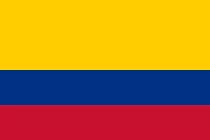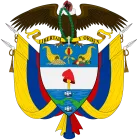Colombia

Geographical Location of Colombia
Colombia is the fourth largest country in South America. It is characterized by mountainous regions in the west and Amazon rainforests in the east. On the border with Ecuador, the Andes are divided into three mountain ranges. There are many mountain peaks here at an altitude of more than 5000 meters above sea level. The Magdalena and Cauca rivers flow between the mountain ranges and it is also the most populated area. The capital Bogota is located on a plateau of one of the eastern mountain ranges. The temperature is constant throughout the year. It's cold in the mountains, and there's always snow on the highest peaks.
About half of Colombia is covered in forests, and deforestation is leading to the extinction of many animal and plant species. Due to excessive use of pesticides, the quality of soil and water is deteriorating. The country lies between two continental plates, which means earthquakes and volcanic eruptions are common here.
Brief History of Colombia
Archaeological finds show that Colombia was inhabited as early as 13,000 years ago. They practiced irrigated agriculture and were among the first to develop complex political systems. In 1499, Spanish conquerors came to Colombia. The country's first city, Santa Marta, was founded in 1525. Colombia was Spain's largest source of gold, and Cartagena quickly became one of the most important ports of the Spanish Empire. Resistance to Spanish rule gradually grew, and, led by heroic liberator Simon Bolivar, independence was achieved in 1819.
The 20th century was characterized by violent conflicts between conservatives and liberals. Only after the military coup of 1953 did they begin to cooperate, and from 1957 they shared power for the next 20 years. The left was excluded from this political cooperation, leading to the emergence of paramilitary and violent guerrilla movements, especially in the cities. After more than 50 years of civil war between the government and local rebel groups, in which drug gangs also played a role, the parties have reached several important peace agreements in recent years.
Society and Politics of Colombia
Colombia is a republic in which the president has executive power and Congress has legislative power. The president is elected by referendum. In such a case, that person serves as president for four years and can only be re-elected once for another four years. Congress consists of two parts: the House of Representatives and the Senate. Members of Congress are also elected by referendum.
The constitution states that citizens' rights must be protected, but during the civil war, gross violations were committed by all sides in the conflict. Colombia is a member of, among others, the UN and the Organization of American States.
Economy and Trade of Colombia
Traditionally, Colombia's economy was based on agriculture, as well as large income from the export of coffee and bananas. Today, oil is Colombia's main legal export.
The country also exports large quantities of illegal cocaine. The export of drugs poses a problem for the police, as large and violent drug cartels have been created that wield enormous power. Colombia's most important trading partners are the US, EU and China, as well as neighboring countries in South America.







